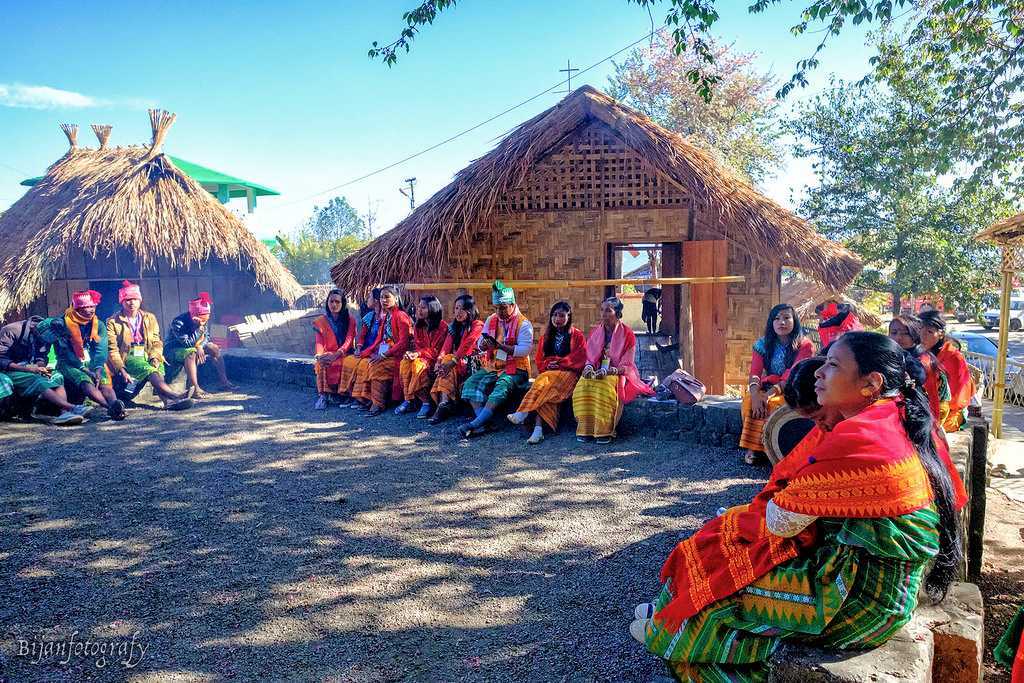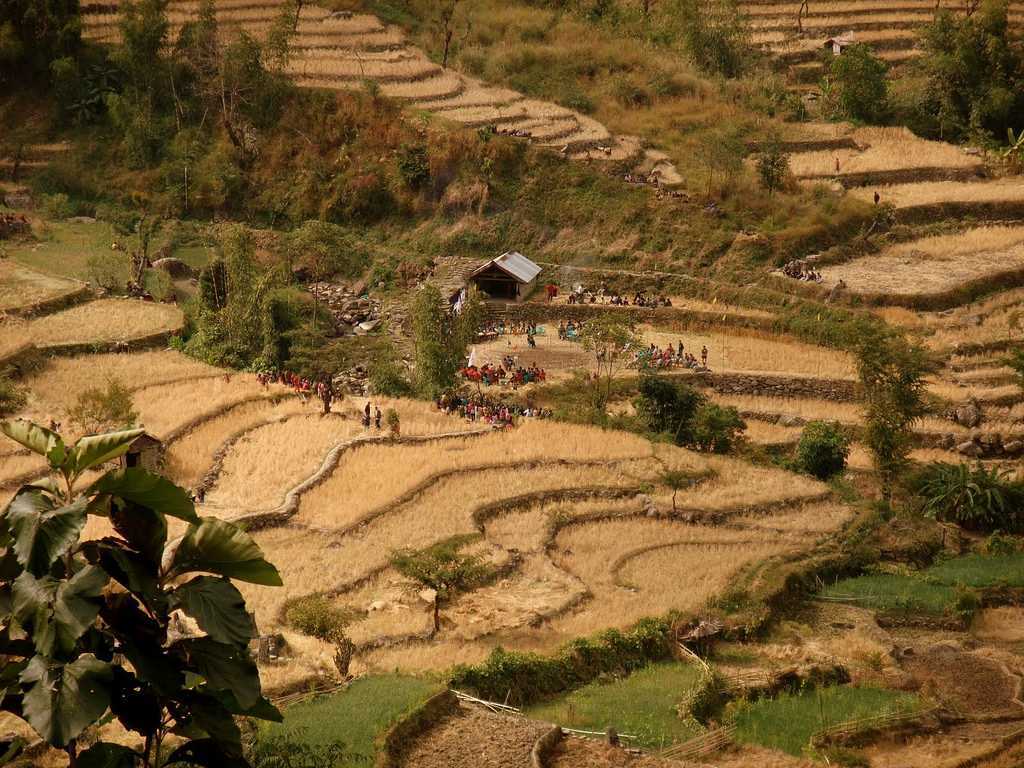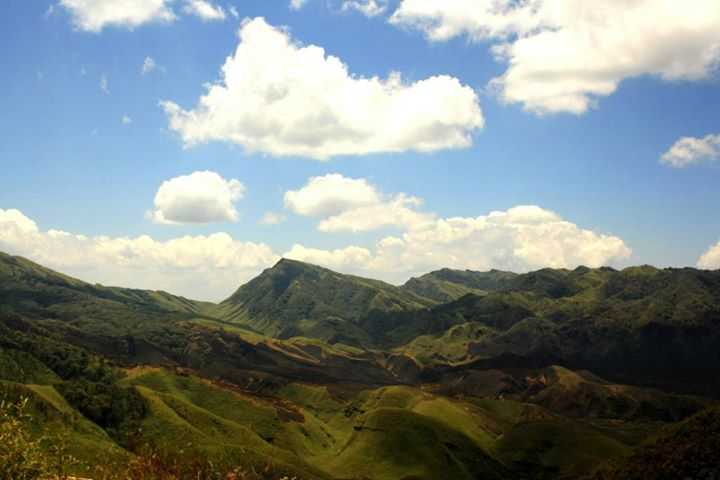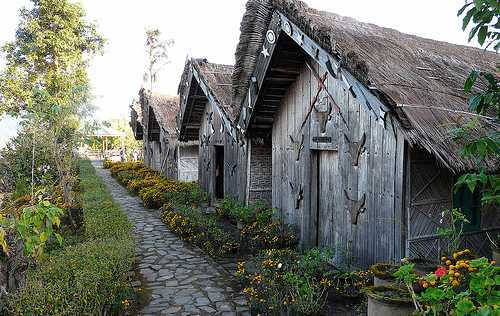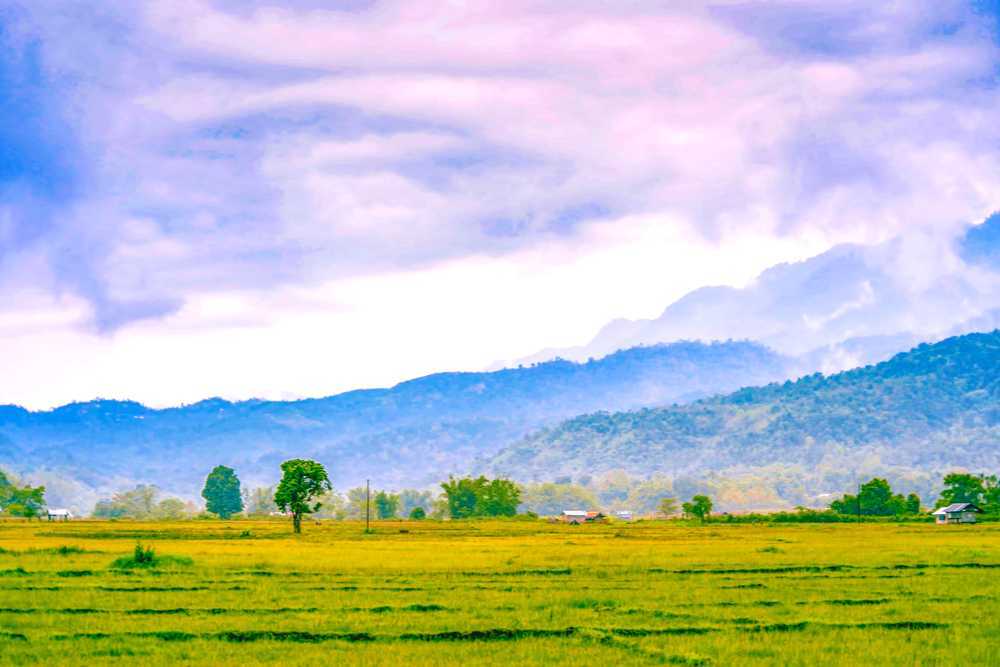KOHIMA
Have you ever felt like you're stuck in a rut, doing the same old thing day in and day out? Do you crave adventure and excitement, but don't know where to start? Well, have no fear because Kohima is here! This charming city in the heart of Nagaland is sure to tickle your fancy and leave you wanting more.
From its rich cultural heritage to its breathtaking natural beauty, Kohima has something for everyone. Whether you're a history buff or an adrenaline junkie, this city will not disappoint. Plus, with its friendly locals and delicious cuisine, you'll feel right at home in no time.
But wait, there's more! Kohima is also home to the infamous Hornbill Festival - a week-long celebration of Naga culture that attracts visitors from all over the world. With traditional dances, music performances and handicrafts on display, this festival is a feast for the senses.
So what are you waiting for? Pack your bags and head to Kohima for an unforgettable adventure. Trust us, you won't regret it!
Table of Contents
- Introduction
- History and Culture of Kohima
- How to Reach and getting around Kohima
- Weather of Kohima
- Places to Visit in Kohima
- Food Options and Local Cuisine of Kohima
- Best areas for Accommodation in Kohima
- Shopping in Kohima
- Nightlife in Kohima
- Festivals and Events in Kohima
- Tips for Travelers travelling to Kohima
- FAQs
History and Culture of Kohima
Kohima is the capital city of Nagaland, a state in India known for its vibrant culture and traditions. The city has a rich history that goes back to the time of the Naga tribes, who were the original inhabitants of the region. The Naga tribes are known for their unique customs and beliefs, which have been passed down from generation to generation.
According to legend, Kohima was founded by a Naga warrior named Khonoma, who was famous for his bravery and leadership skills. Khonoma is still revered as a hero in Nagaland today, and his legacy lives on in the city he founded.
Over the years, Kohima has seen many changes and developments, including being occupied by Japanese forces during World War II. The war left its mark on Kohima, with several monuments and memorials commemorating the brave soldiers who fought and died there.
Today, Kohima is a bustling city that celebrates its unique culture through festivals like Hornbill Festival, which showcases traditional Naga dances, music, and food. The festival attracts visitors from all over India and around the world, making it a must-visit destination for anyone interested in experiencing Nagaland's vibrant culture firsthand.
Apart from its cultural heritage, Kohima is also famous for its natural beauty - with lush green hills and valleys surrounding the city. Visitors can explore these scenic spots through trekking trails or by taking a cable car ride to get an aerial view of the city's picturesque landscape.
In conclusion, Kohima is a fascinating destination that offers visitors an opportunity to learn about Naga culture while also enjoying natural beauty at its best. From historic monuments to cultural festivals to stunning landscapes - Kohima has something for everyone!
How to Reach and getting around Kohima
Kohima, the capital of Nagaland, is a beautiful city nestled in the northeastern corner of India. It is well-connected to the rest of the country through various modes of transportation. Here are some options on how to reach Kohima:
By Air: The nearest airport to Kohima is Dimapur Airport, which is approximately 74 km away. From there, you can take a taxi or bus to reach Kohima. The airport has regular flights from major cities like Kolkata, Delhi, and Guwahati.
By Train: The nearest railway station to Kohima is Dimapur Railway Station, which is around 72 km away. You can take a taxi or bus from there to reach Kohima. The station has trains that run from major cities like Kolkata, Guwahati, and Delhi.
By Road: You can also reach Kohima by road as it has well-connected highways that link it to other cities in Nagaland as well as neighboring states like Assam and Manipur. There are regular buses and taxis that run between these places.
By Bike/Car: If you're an adventure lover and prefer driving yourself, you can rent a bike/car from nearby cities like Guwahati or Imphal and drive down to Kohima. The scenic beauty of the winding roads through the hills will make for an unforgettable journey.
By Trekking: For those who love trekking, there are several trekking routes that lead up to Kohima from nearby villages and towns. It's an excellent way to explore the natural beauty of Nagaland while getting some exercise.
In conclusion, there are multiple options on how to reach Kohima that cater to different preferences and budgets. Whether you choose air travel or want to drive down yourself, your journey will be full of exciting experiences that will stay with you for a long time.
Weather of Kohima












 Extreme Winters
Extreme Winters Mild Winters
Mild Winters Hot + Dry
Hot + Dry Hot + Humid
Hot + Humid Rainy
Rainy Cool and Pleasant
Cool and PleasantKohima, the capital city of Nagaland, experiences a moderate climate throughout the year. The temperature in Kohima remains pleasant with average temperatures ranging from 16°C to 25°C. The city receives heavy rainfall during the monsoon season, which starts from June and lasts till September. The winter season in Kohima is mild, and the temperature can drop to 4°C during the night.
The best time to visit Kohima is from October to May when the weather remains dry and pleasant. During this period, visitors can explore the natural beauty of Kohima without any hindrance. Moreover, this is also the time when many festivals are celebrated in Kohima, making it an ideal time for tourists to experience the rich culture and traditions of Nagaland.
In October, Nagaland celebrates its biggest festival – Hornbill festival – which showcases different tribes' customs and traditions through music, dance performances, food stalls, and handicrafts exhibition. In addition to this festival, tourists can also witness other festivals such as Sekrenyi in February and Moatsu in May.
In conclusion, while Kohima experiences a moderate climate throughout the year, October to May is undoubtedly the best time to visit this beautiful city due to dry weather conditions and various cultural events that take place during this period.
Places to Visit in Kohima
- War Cemetery:
The War Cemetery is a must-visit place in Kohima. It is a memorial for the soldiers who lost their lives in the Battle of Kohima during the Second World War. The cemetery is well-maintained and provides an insight into the history of the region.
- Kohima Museum:
Kohima Museum is a great place to learn about Naga culture and heritage. The museum has a collection of artifacts, photographs, and documents that showcase the rich history of the region.
- Dzukou Valley:
Dzukou Valley is a breathtakingly beautiful valley that offers stunning views of lush green hills and valleys covered with flowers. The valley is popular among trekkers and nature lovers.
- Japfu Peak:
Japfu Peak is one of the highest peaks in Nagaland, standing at an elevation of 3048 meters above sea level. It offers panoramic views of Kohima city and its surroundings.
- Khonoma Village:
Khonoma Village is known for its rich cultural heritage and traditional way of life. The village has several traditional houses, each with its unique design and style.
- Nagaland State Museum:
Nagaland State Museum offers an insight into the state's history, culture, and traditions through its collection of artifacts, photographs, documents, and artworks.
- Catholic Church:
The Catholic Church in Kohima is one of the most beautiful churches in Nagaland. It was built in 1948 and features Gothic architecture.
- Touphema Village:
Touphema Village is a popular tourist destination that showcases the traditional way of life of Nagas through its eco-tourism initiatives such as homestays, cultural programs, and nature walks.
- Kachari Ruins:
Kachari Ruins are ancient ruins dating back to the 10th century AD when they were inhabited by Kachari rulers. Today, only remnants remain that provide insight into their architectural style.
- Naga Bazaar:
Naga Bazaar is a bustling marketplace where tourists can find traditional Naga handicrafts such as shawls, bags, baskets made from bamboo or cane, wood carvings, jewelry made from bones or beads at reasonable prices.
Overall these places offer history lessons about Nagaland's past as well as showcasing natural beauty unique to this part of India!
Relaxing Retreats
Hilly Regions
Nearby Forests
Food Options and Local Cuisine of Kohima
Best areas for accommodation in Kohima
Kohima is the capital city of Nagaland, known for its lush green hills, vibrant culture, and warm hospitality. The city has a variety of areas where tourists can stay during their visit. Here are some of the best areas for accommodation in Kohima:
PR Hill: This is one of the most popular areas for accommodation in Kohima. It is located near the city center and offers easy access to major attractions in the city.
Mission Compound: This area is known for its peaceful ambiance and beautiful surroundings. It is an ideal place to stay for those who want to experience the natural beauty of Kohima.
P.R. Hill Colony: This area is located on a hilltop and offers breathtaking views of the city below. It has several hotels and guesthouses that cater to tourists with different budgets.
Here are three properties for accommodation in Kohima:
Japfu Hotel (Luxury): This hotel is located in PR Hill and offers luxurious rooms with modern amenities such as air conditioning, TV, and minibar. It also has a restaurant that serves delicious local and international cuisine.
Hotel Cimorb (Budget): Located in Mission Compound, this hotel offers comfortable rooms at an affordable price. The rooms are equipped with basic amenities such as TV, hot water, and Wi-Fi.
The Wanderer's Nest Hostel (Hostel): This hostel is located in PR Hill Colony and offers budget-friendly accommodation for backpackers and solo travelers. It has dormitory-style rooms as well as private rooms with shared bathrooms.
Overall, Kohima has a variety of areas for accommodation that cater to all kinds of travelers. Whether you're looking for luxury or budget-friendly options, you're sure to find something that suits your needs in this beautiful city.
Shopping in Kohima
Kohima, the capital city of Nagaland, is a vibrant shopping destination for tourists. The city offers a range of products that are unique to the region, including traditional Naga shawls, handicrafts, and local delicacies. The markets in Kohima are bustling with activity, and visitors can easily get lost in the maze of stalls and shops. To help you navigate through the city's shopping scene, we have compiled a list of things to buy, markets to visit, and things to avoid.
Things to Buy
- Traditional Naga shawls
- Handicrafts made by local artisans
- Local spices and herbs
- Fresh fruits and vegetables
Markets to Visit
- The Main Market: This market is located in the heart of Kohima and is known for its colorful stalls selling everything from clothes to food items.
- Super Market: This market is popular among tourists for its range of handicrafts made by local artisans.
- Keeda Bazaar: This market is famous for its fresh produce such as fruits and vegetables.
What to Avoid
- Fake souvenirs: Be wary of shops selling fake souvenirs that claim to be made by local artisans.
- Street food: Avoid eating street food as it might not be hygienic.
- Overpriced products: Bargain hard before buying any product as some shopkeepers might charge exorbitant prices.
- Crowded areas: Be cautious while walking through crowded areas as pickpockets are common in such places.
Overall, shopping in Kohima is an exciting experience that offers a glimpse into the rich culture and traditions of Nagaland. Visitors can explore the bustling markets filled with indigenous products while avoiding scams or overpriced goods. So if you're looking for unique souvenirs or local delicacies, Kohima should definitely be on your list.
Nightlife in Kohima
Kohima, the capital of Nagaland, is a hub of cultural and scenic beauty. Its nightlife is not like other cities in India, but it does offer a unique experience. The city has an excellent nightlife culture that showcases the Naga people's traditional music and dance while integrating modern sounds and beats.
The streets of Kohima come alive at night, with illuminated shops, restaurants, and bars. The young crowd flocks to pubs and clubs to enjoy live music performances and DJ nights.
Here are three places that you can visit to experience Kohima's nightlife:
Dream Cafe: Dream Cafe is one of the coolest places in Kohima to spend your night. The cafe serves delicious food and drinks with live music performances. It has a cozy ambiance, perfect for having a conversation with friends or colleagues.
The Heritage: The Heritage is a popular bar in Kohima that offers great cocktails, beers, and other drinks. It also hosts live music performances and DJ nights on weekends.
Kisama Heritage Village: If you want to experience the traditional Naga culture at night, Kisama Heritage Village is an excellent place to visit. It hosts various cultural programs showcasing Naga folk dances, songs, and handicrafts.
In conclusion, Kohima's nightlife may not be as vibrant as other Indian cities but still offers a unique experience. If you're visiting Kohima anytime soon, don't forget to check out these three places for an unforgettable night out!
Outdoor Activities in Kohima
Kohima, the capital city of Nagaland, is not just known for its vibrant nightlife but also for its outdoor activities. Adventure enthusiasts can indulge in a range of outdoor activities in Kohima that cater to all age groups. The city offers a perfect blend of natural beauty and adventure sports that promise an unforgettable experience.
Trekking is one of the most popular outdoor activities in Kohima. The rugged terrain and undulating hills offer some breathtaking trekking trails that lead to scenic destinations. Trekking through the lush green forests, passing through small villages, and crossing streams make for an exhilarating experience.
Another exciting activity is Rock Climbing, which can be enjoyed by both beginners and experienced climbers. The natural rock formations in Kohima provide ample opportunities for rock climbing enthusiasts to test their skills.
For those who love water sports, Rafting on the Doyang River is a must-try activity. The river's gushing rapids offer an adrenaline-pumping experience as you navigate through the twists and turns of the river.
In addition to these activities, visitors can also indulge in camping, bird-watching, cycling, and picnicking amidst nature's bounty. Kohima's serene surroundings make it an ideal location for nature lovers looking to escape the hustle-bustle of city life.
So if you're looking for some adventure and fun-filled activities amidst breathtaking scenery, head over to Kohima and indulge in these exciting outdoor activities.
Festivals and Events in Kohima
Kohima, the capital city of Nagaland, is known for its vibrant festivals and events that showcase the rich cultural heritage of the state. These celebrations are an integral part of the Naga way of life and are eagerly awaited by locals and tourists alike. Here are some of the most popular festivals and events in Kohima:
Hornbill Festival (December): This 10-day festival is a celebration of Naga culture, music, dance, food, and sports. It takes place from December 1-10 every year and attracts thousands of visitors from all over India and abroad. The festival features traditional performances by various tribes, a night bazaar, a craft fair, a food festival, and sports competitions.
Moatsu Festival (May): This festival is celebrated by the Ao tribe in early May to mark the end of the sowing season. It includes prayers, feasting, dancing, singing, and traditional games like wrestling and archery.
Tsungremong Festival (August): This festival is observed by the Ao tribe in August to express gratitude for a good harvest. It involves offerings to ancestors and deities, community feasting, singing, dancing, and traditional games.
Sekrenyi Festival (February): This festival is celebrated by the Angami tribe in February to purify oneself before the new harvest season begins. It includes rituals like cleansing with water, feasting on meat dishes, singing traditional songs called 'Li', dancing in circles around a bonfire called 'Thekra Hie', and exchanging gifts.
In addition to these festivals, Kohima also hosts several other events throughout the year such as:
Naga Chef Season 5 (October-November): A cooking competition that showcases Naga cuisine.
Kohima Christmas Carol Festival (December): A musical extravaganza featuring choirs from various churches.
Kohima Night Carnival (December-January): A street carnival featuring food stalls, games stalls, music bands etc.
These festivals and events offer a glimpse into the unique culture of Nagaland and provide an opportunity for visitors to interact with locals and experience their hospitality firsthand.
Tips for Travelers while travelling to Kohima
- Plan your trip around the festivals: Kohima is known for its vibrant festivals and events, so make sure to check the calendar before booking your trip. The Hornbill Festival, in particular, is a must-see for visitors interested in experiencing the rich Naga culture.
- Pack appropriately: Kohima's climate can be unpredictable, so pack clothes that are suitable for both warm and cool weather. Additionally, comfortable shoes are a must for exploring the city's hilly terrain and attending festival events.
- Respect local customs: The people of Kohima are proud of their heritage, so it's important to be respectful of their customs and traditions. Dress modestly, ask for permission before taking photos or videos, and avoid touching any religious or cultural artifacts without permission.
- Try local cuisine: Naga cuisine is known for its unique blend of spices and flavors. Don't miss out on trying local specialties like smoked pork or bamboo shoot pickle while in Kohima. However, keep in mind that some dishes can be quite spicy - be sure to clarify your spice tolerance with restaurant staff before ordering.
- Stay safe: While Kohima is generally a safe city for travelers, it's still important to take precautions like keeping an eye on your belongings and avoiding walking alone at night. If you're attending festival events, stay aware of your surroundings and follow any instructions from event organizers or security personnel.
Overall, traveling to Kohima can be an enriching experience for those interested in learning about Naga culture and history. By following these tips and being respectful of local customs, you can make the most out of your trip to this vibrant city.
FAQs
What is Kohima?
Kohima is the capital city of the Indian state of Nagaland. It is situated in the northeastern part of India and is known for its rich cultural heritage, beautiful landscapes, and historical significance.
What are some popular places to visit in Kohima?
Some popular places to visit in Kohima include the Kohima War Cemetery, Naga Heritage Village, Dzukou Valley, Khonoma Village, Japfu Peak, and the State Museum.
What is the best time to visit Kohima?
The best time to visit Kohima is from October to May. During this time, the weather remains mild with pleasant temperatures and low humidity. The monsoon season in Kohima starts from June and lasts till September making it difficult for tourists to enjoy outdoor activities.
How can one reach Kohima?
One can reach Kohima by air, rail or road. The nearest airport is Dimapur Airport which is about 74 km away from Kohima. The nearest railway station is Dimapur Railway Station which is around 70 km away. One can also take a bus or taxi from Guwahati or Imphal to reach Kohima.
Is it safe to travel to Kohima?
Yes, it is safe to travel to Kohima. However, like any other place in the world, travelers should take precautions such as avoiding isolated areas at night and not carrying expensive items with them.
What are some local dishes in Kohima?
Some popular local dishes in Kohima include smoked pork cooked with bamboo shoots and fermented soybeans (axone), steamed dumplings filled with meat or vegetables (momos), fish cooked with bamboo shoots (bamboo fish), and rice beer (zu).
What are some cultural events celebrated in Kohima?
Some cultural events celebrated in Kohima include Hornbill Festival (December), Aoleang Festival (April), Sekrenyi Festival (February), Moatsu Festival (May), and Tuluni Festival (July). These festivals showcase Nagaland's rich culture through music, dance, food, fashion shows and sporting events.
